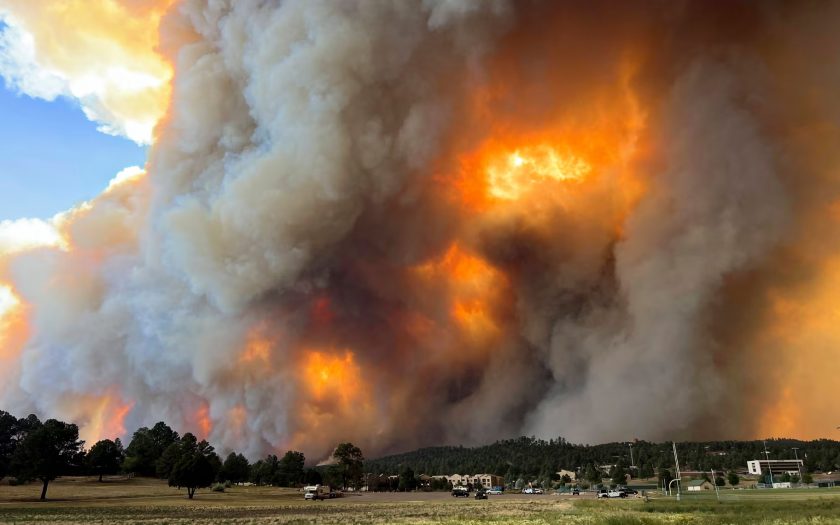A Perfect Storm of Disaster
Last week was a terrifying one for New Mexico as the land of enchantment faced both wildfires and flash floods. The stark change in weather occurrences helped emphasize the risks associated with severe weather and where climate change has a growing effect.
Wildfire Fury:
Drought conditions and soaring temperatures for weeks ahead meant the stage was set for disaster. It was a tinderbox landscape just waiting to hit a spark. As flames roared, fanned by powerful winds, they quickly raced across the state. Residents watched as the flames roared down on their homes, communities were evacuated and firefighters fought a nonstop battle against the inferno.
A Deceptive Shift:
At just the moment the wildfires looked to be contained, a tropical storm developing in the Gulf of Mexico gave some optimism. What first seemed like a break from the drought soon became a double-edged sword. The storm spawned heavy rain and golf ball-sized hail that lashed the newly burned areas.
Flash Flood Fury:
It came in this new and unexpected form: a rainstorm that seemed to burst from the sky. That land, burnt and cleared of its vegetation, then lost that all-important ability to hold onto water. This was a recipe for flash flooding. Flood waters, loaded with the ash and debris of the fires raged down upon towns and villages like a biblical plague. Porches were blown away, roads became roiling rivers of water, and power lines were toppled. This abrupt, forceful deluge killed some innocents.
The Devastating Aftermath
The impact of this one-two punch from nature was far-reaching, and in some cases, catastrophic:
- Loss of life and property:
The biggest loss in this disaster (was human lives) It caused lives to be lost, and homes washed away, many families and even a few communities in shock. Repairing fractured lives and shattered infrastructure will take time and effort. Those were the imperative missions immediately afterward and during initial recovery operations. Local community groups and volunteers helped by offering temporary accommodation and food as well as emotional support to people dealing with the situation.
- Infrastructure damage:
Roads were turned into rivers, bridges buckled under the flow of incredible amounts of water, and power lines were cut. This damage to critical infrastructure cuts communities off from each other and cripples recovery. The focus then shifts to restoring transportation and communication networks so that emergency services can reach the affected areas and essential supplies can be sent in.
- Environmental Concern:
The flood washed up ash and debris that put aquatic life in rivers and streams through hard times. Wildfires can also lead to a loss of vegetation that helps hold the soil, again making it more likely to soothe off or erode in future storm events. Environmental agencies are working to assess damage and control the long-term ecological impacts. This may include replanting trees and other vegetation to restore natural habitats and halt soil erosion.
A Call to Action: Building Resilience
The trials in New Mexico act as a vivid support of the increasing dangers of extreme weather. Climate change is one of the most probable factors tied to these events as well; its effects are inducing more unpredictable and extreme weather patterns.
In the longer term, there are several important parts of ensuring that our community as a whole remains resilient into the future:
- Enhanced Wildfire Management:
Better technology for early detection, planned burns, and sustainable forest management can make it less likely that super-charged wildfires will occur. This might mean technologies such as high-tech fire spotting and starter systems, and the planting of controlled burns to remove dead and combustible plants.
- Flood Plain Management:
Identifying flood-prone areas and zoning can reduce future damage by dissuading developments in areas vulnerable to anticipated future flooding. Floodplain maps help delineate these areas, where zoning may be used to limit development or require specific building construction in flood-prone areas.
- Infrastructure Resiliency:
Investments in infrastructure such as roads, bridges, and power lines that are constructed to a standard to withstand extreme weather events can help protect communities and decrease the time of recovery. This might include building roads and bridges at higher elevations or using a different type of material that can adequately support the weight of passing floodwaters. This includes hardening power lines to withstand high winds and heavier rainfall that may come as a result of climate change, reducing the number of residents affected by any future outages.
- Public Education:
Fire safety and flood preparedness education can help residents and communities arm themselves with information about how to safeguard their lives and property. It may do so via public awareness efforts, workshops, and educational materials that inform people about creating (and maintaining) defensible spaces around their homes in case of wildfires or provide guidelines for how to plan for and evacuate in the event of floods.
A Community’s Strength and the Path Forward
This week’s story of New Mexico is one of hardship and hope. As big as the devastation is the spirits of the people are still damn near unbreakable. Communities can grow more resilient by using this experience to learn and take advantage of the potential opportunities ahead in the face of a dynamically changing climate. Helping those affected to get their lives back on track is also important, and the more support that is offered to them, the better. This could mean aiding financially, through volunteer support and mental health resources to help individuals with trauma reasoning that would have been the result of this.
Unfortunately, New Mexico provides a cautionary reminder about what has happened and continues to happen in this country and around the world. With the increasing threat of extreme weather events, anticipatory planning and community resilience are needed. Through learning form this experience, by investing in mitigation strategies, and by fostering a cooperative spirit, communities can navigate the storms that still lie ahead - both literal and metaphorical.

